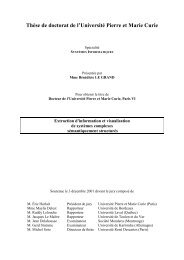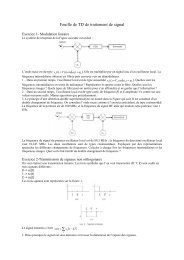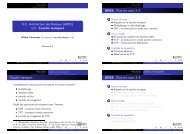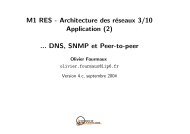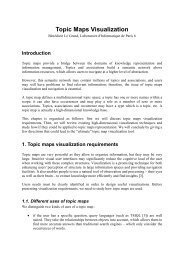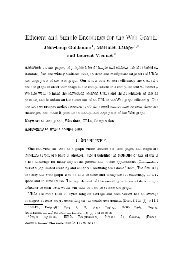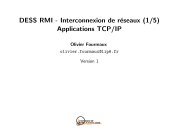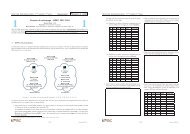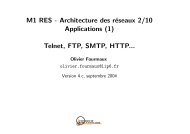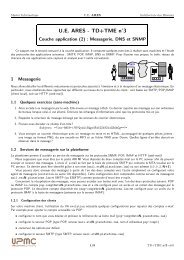U.E. Architecture des Réseaux (ARES) 1/5 : Introduction - LIP6
U.E. Architecture des Réseaux (ARES) 1/5 : Introduction - LIP6
U.E. Architecture des Réseaux (ARES) 1/5 : Introduction - LIP6
You also want an ePaper? Increase the reach of your titles
YUMPU automatically turns print PDFs into web optimized ePapers that Google loves.
Présentation de l’U.E. <strong>ARES</strong><br />
Questions administratives<br />
Rappels et introduction au contenu de l’U.E.<br />
Présentation de l’U.E. <strong>ARES</strong><br />
Questions administratives<br />
Rappels et introduction au contenu de l’U.E.<br />
<strong>ARES</strong> : Plan du cours 1/5<br />
U.E. <strong>Architecture</strong> <strong>des</strong> Réseaux (<strong>ARES</strong>)<br />
1/5 : <strong>Introduction</strong><br />
Olivier Fourmaux (olivier.fourmaux@upmc.fr)<br />
Version 6.1<br />
1 Présentation de l’U.E. <strong>ARES</strong><br />
Objectifs de l’U.E.<br />
Démarche pédagogique<br />
Moyens pédagogiques<br />
2 Questions administratives<br />
Planning<br />
Evaluation<br />
3 Rappels et introduction au contenu de l’U.E.<br />
Composants du réseau<br />
Hiérarchie protocolaire<br />
Exemple avec TCP/IP<br />
Olivier Fourmaux (olivier.fourmaux@upmc.fr)<br />
U.E. <strong>Architecture</strong> <strong>des</strong> Réseaux (<strong>ARES</strong>) 1/5 : <strong>Introduction</strong><br />
Olivier Fourmaux (olivier.fourmaux@upmc.fr)<br />
U.E. <strong>Architecture</strong> <strong>des</strong> Réseaux (<strong>ARES</strong>) 1/5 : <strong>Introduction</strong><br />
Présentation de l’U.E. <strong>ARES</strong><br />
Questions administratives<br />
Rappels et introduction au contenu de l’U.E.<br />
<strong>ARES</strong> : Plan du cours 1/5<br />
Objectifs de l’U.E.<br />
Démarche pédagogique<br />
Moyens pédagogiques<br />
Présentation de l’U.E. <strong>ARES</strong><br />
Questions administratives<br />
Rappels et introduction au contenu de l’U.E.<br />
Objectifs de l’U.E.<br />
Démarche pédagogique<br />
Moyens pédagogiques<br />
Renforcer ses connaissances en réseau<br />
1 Présentation de l’U.E. <strong>ARES</strong><br />
Objectifs de l’U.E.<br />
Démarche pédagogique<br />
Moyens pédagogiques<br />
2 Questions administratives<br />
Planning<br />
Evaluation<br />
3 Rappels et introduction au contenu de l’U.E.<br />
Composants du réseau<br />
Hiérarchie protocolaire<br />
Exemple avec TCP/IP<br />
Approfondir et compléter un cours d’introduction aux réseaux<br />
exemple : cours LI310 de la Licence d’Informatique de l’UPMC<br />
prérequis techniques et théoriques (supposés acquis) :<br />
vocabulaire spécifique<br />
introduction au traitement du signal<br />
mécanismes protocolaires de base<br />
protocoles usuels (HDLC, X25, IP, routage, UDP, TCP)<br />
modèle en couches OSI<br />
Olivier Fourmaux (olivier.fourmaux@upmc.fr)<br />
U.E. <strong>Architecture</strong> <strong>des</strong> Réseaux (<strong>ARES</strong>) 1/5 : <strong>Introduction</strong><br />
Olivier Fourmaux (olivier.fourmaux@upmc.fr)<br />
U.E. <strong>Architecture</strong> <strong>des</strong> Réseaux (<strong>ARES</strong>) 1/5 : <strong>Introduction</strong>
Présentation de l’U.E. <strong>ARES</strong><br />
Questions administratives<br />
Rappels et introduction au contenu de l’U.E.<br />
Maîtriser les technologies de base<br />
Objectifs de l’U.E.<br />
Démarche pédagogique<br />
Moyens pédagogiques<br />
Présentation de l’U.E. <strong>ARES</strong><br />
Questions administratives<br />
Rappels et introduction au contenu de l’U.E.<br />
Objectifs de l’U.E.<br />
Démarche pédagogique<br />
Moyens pédagogiques<br />
Base pour les autres U.E. de la spécialité RES<br />
U.E. pré-requise pour les cours de réseaux avancées<br />
Etudier la principale architecture de réseau actuelle ainsi que son<br />
environnement ➠ TCP/IP et Internet<br />
applications normalisées (Web, DNS, messagerie...)<br />
mécanismes dynamiques (contrôle de la congestion...)<br />
adressage IPv4 (CIDR, DHCP, NAT, tunnels...)<br />
routage avancé (hiérarchie d’AS, OSPF, BGP...)<br />
architectures supports (Ethernet, liaisons point-à-point...)<br />
boucle locale (CATV, ADSL, FTTH...)<br />
en M1-S2 pour les étudiants de RES (U.E. obligatoires) ou<br />
pour les étudiants <strong>des</strong> autres spécialités (U.E. libre) :<br />
IPv6, multicast, QoS, sécurité ➠ U.E. ING<br />
mobilité, autonomie, sans-fil ➠ U.E. MOB<br />
Olivier Fourmaux (olivier.fourmaux@upmc.fr)<br />
U.E. <strong>Architecture</strong> <strong>des</strong> Réseaux (<strong>ARES</strong>) 1/5 : <strong>Introduction</strong><br />
Olivier Fourmaux (olivier.fourmaux@upmc.fr)<br />
U.E. <strong>Architecture</strong> <strong>des</strong> Réseaux (<strong>ARES</strong>) 1/5 : <strong>Introduction</strong><br />
Présentation de l’U.E. <strong>ARES</strong><br />
Questions administratives<br />
Rappels et introduction au contenu de l’U.E.<br />
Objectifs de l’U.E.<br />
Démarche pédagogique<br />
Moyens pédagogiques<br />
Base pour les autres U.E. de la spécialité RES<br />
Présentation de l’U.E. <strong>ARES</strong><br />
Questions administratives<br />
Rappels et introduction au contenu de l’U.E.<br />
Contenu du cours<br />
Objectifs de l’U.E.<br />
Démarche pédagogique<br />
Moyens pédagogiques<br />
U.E. pré-requise pour les cours de réseaux avancées<br />
en M1-S2 pour les étudiants de RES (U.E. obligatoires) ou<br />
pour les étudiants <strong>des</strong> autres spécialités (U.E. libre) :<br />
IPv6, multicast, QoS, sécurité ➠ U.E. ING<br />
mobilité, autonomie, sans-fil ➠ U.E. MOB<br />
en M2 pour les étudiants de RES (PRO/ALT ou RECH) :<br />
applications multimédia ➠ U.E. APMM<br />
transferts multimédia sur réseaux IP ➠ U.E. MMIP<br />
multimédia et qualité de service ➠ U.E. MMQoS<br />
routage et routeurs ➠ U.E. ROUT<br />
sécurité <strong>des</strong> réseaux ➠ U.E. SECUR<br />
services mobiles ➠ U.E. SMOB<br />
supervision de réseaux ➠ U.E. SUPERV<br />
trafic et contrôle <strong>des</strong> réseaux ➠ U.E. TCONT ...<br />
Approche Top down :<br />
Partie 1/5 <strong>Introduction</strong><br />
Partie 2/5 Application : Telnet, FTP, SMTP, HTTP,<br />
... DNS, SNMP, peer-to-peer.<br />
Partie 3/5 Transport : services, exemples UDP et TCP,<br />
... contrôle de congestion.<br />
Partie 4/5 Réseau : IPv4, adressage CIDR, translation...<br />
... routage hiérarchique, OSPF et BGP.<br />
Partie 5/5 Technologies support : Ethernet commuté,<br />
... point-à-point, boucle locale.<br />
Olivier Fourmaux (olivier.fourmaux@upmc.fr)<br />
U.E. <strong>Architecture</strong> <strong>des</strong> Réseaux (<strong>ARES</strong>) 1/5 : <strong>Introduction</strong><br />
Olivier Fourmaux (olivier.fourmaux@upmc.fr)<br />
U.E. <strong>Architecture</strong> <strong>des</strong> Réseaux (<strong>ARES</strong>) 1/5 : <strong>Introduction</strong>
Présentation de l’U.E. <strong>ARES</strong><br />
Questions administratives<br />
Rappels et introduction au contenu de l’U.E.<br />
Objectifs de l’U.E.<br />
Démarche pédagogique<br />
Moyens pédagogiques<br />
Intégration <strong>des</strong> travaux dirigés et sur machine<br />
Présentation de l’U.E. <strong>ARES</strong><br />
Questions administratives<br />
Rappels et introduction au contenu de l’U.E.<br />
Objectifs de l’U.E.<br />
Démarche pédagogique<br />
Moyens pédagogiques<br />
Contenu <strong>des</strong> séances de TD+TME (sous réserves)<br />
Intégration <strong>des</strong> Travaux Dirigés (TD) et Travaux sur Machine<br />
Encadré (TME) dans une même séance : TD+TME<br />
entrelacement <strong>des</strong> aspects théoriques et pratiques<br />
illustration par <strong>des</strong> exemples concrets sur une plateforme<br />
d’expérimentation avec du matériel réseau réel :<br />
Salle M2-RES de 2003 à 2009<br />
X 16<br />
Internet<br />
via ARI<br />
X 16<br />
Internet<br />
via ARI<br />
Salle M2-RES depuis 2009<br />
ctrl console<br />
PC 1U "sonde"<br />
Routeur<br />
PC 1U "client"<br />
PC 1U "serveur"<br />
ctrl alim.<br />
Commutateur<br />
séance contenu support<br />
1 <strong>Introduction</strong> à la plateforme de TME n°1<br />
2 Applications (1) : analyse Telnet, FTP et Web n°2<br />
3 Applications (2) : analyse SMTP, DNS, SNMP n°3<br />
4 Transport (1) : analyse <strong>des</strong> mécanismes n°4<br />
5 Transport (2) : contrôle de congestion n°5<br />
6 Fin TD+TME précédents, révisions<br />
7 Correction examen, Réseau (1) : IP/ICMP n°6<br />
8 Réseau (2) : routage et filtrage n°7<br />
9 Réseau (3) : PPP et tunnels n°8<br />
10 Fin TD+TME précédents, révisions<br />
Olivier Fourmaux (olivier.fourmaux@upmc.fr)<br />
U.E. <strong>Architecture</strong> <strong>des</strong> Réseaux (<strong>ARES</strong>) 1/5 : <strong>Introduction</strong><br />
Olivier Fourmaux (olivier.fourmaux@upmc.fr)<br />
U.E. <strong>Architecture</strong> <strong>des</strong> Réseaux (<strong>ARES</strong>) 1/5 : <strong>Introduction</strong><br />
Présentation de l’U.E. <strong>ARES</strong><br />
Questions administratives<br />
Rappels et introduction au contenu de l’U.E.<br />
Organisation de l’enseignement<br />
Objectifs de l’U.E.<br />
Démarche pédagogique<br />
Moyens pédagogiques<br />
Présentation de l’U.E. <strong>ARES</strong><br />
Questions administratives<br />
Rappels et introduction au contenu de l’U.E.<br />
Plateforme de TD+TME<br />
Objectifs de l’U.E.<br />
Démarche pédagogique<br />
Moyens pédagogiques<br />
13 semaines avec :<br />
10 * 2h de cours<br />
O. Fourmaux<br />
10 * (4h de TD+TME)<br />
O. Fourmaux, B. Le Grand, K. Thai et T. Bourgeau<br />
Quelques liens utiles...<br />
site permanent de l’U.E. <strong>ARES</strong> sur le site du Master :<br />
http://www-master.ufr-info-p6.jussieu.fr/ue/MI011<br />
site temporel de l’U.E. <strong>ARES</strong> (nouvelles brèves, planning,<br />
supports et autres documents...) :<br />
http://www-master.ufr-info-p6.jussieu.fr/2011/ares<br />
Plateforme matérielle d’expérimentation<br />
(utilisation de la salle M2-RES).<br />
Chaque binôme a accès à :<br />
un poste ARI standard<br />
<strong>des</strong> équipements réseau dédiés pour<br />
réaliser les différentes configurations,<br />
captures et analyses :<br />
1 commutateur CISCO<br />
1 routeur CISCO<br />
3 PC “rackables” 1U<br />
Olivier Fourmaux (olivier.fourmaux@upmc.fr)<br />
U.E. <strong>Architecture</strong> <strong>des</strong> Réseaux (<strong>ARES</strong>) 1/5 : <strong>Introduction</strong><br />
Olivier Fourmaux (olivier.fourmaux@upmc.fr)<br />
U.E. <strong>Architecture</strong> <strong>des</strong> Réseaux (<strong>ARES</strong>) 1/5 : <strong>Introduction</strong>
Présentation de l’U.E. <strong>ARES</strong><br />
Questions administratives<br />
Rappels et introduction au contenu de l’U.E.<br />
Supports de cours/TD+TME<br />
Objectifs de l’U.E.<br />
Démarche pédagogique<br />
Moyens pédagogiques<br />
Présentation de l’U.E. <strong>ARES</strong><br />
Questions administratives<br />
Rappels et introduction au contenu de l’U.E.<br />
Bibliographie<br />
Objectifs de l’U.E.<br />
Démarche pédagogique<br />
Moyens pédagogiques<br />
traces de trafic réseau (validation <strong>des</strong> acquis de l’U.E.)<br />
réalisées sur la plateforme dans le cadre <strong>des</strong> TD+TME<br />
réalisées par les étudiants (sur la plateforme ou ailleurs...)<br />
pré-enregistrées (en cas de panne ou pour travailler de<br />
l’extérieur) sur la page web :<br />
http://www-rp.lip6.fr/~fourmaux/Traces/tracesV6.html<br />
autres supports disponibles sur le site de l’U.E. <strong>ARES</strong> et sur :<br />
http://www-rp.lip6.fr/~fourmaux/index-cours.html<br />
transparents de cours<br />
sujets de TD+TME (avec <strong>des</strong> contenus facultatifs)<br />
annales<br />
bibliographie<br />
titres disponibles à la bibliothèque Math/Info<br />
➠ préférez les versions originales...<br />
James F. KUROSE et Keith W. ROSS :<br />
Computer Networking : A Top-down Approach Featuring<br />
the Internet, 5 d edition (Pearson)<br />
Analyse structurée <strong>des</strong> réseaux (Pearson)<br />
Andrew S. TANENBAUM :<br />
Computer Networks, 4 th edition (Prentice Hall)<br />
Réseaux (Pearson)<br />
Douglas COMER :<br />
Internetworking with TCP/IP Vol 1 : Principles, Protocols<br />
and <strong>Architecture</strong>s, 5 th edition (Prentice Hall)<br />
TCP/IP : architecture, protocoles et applications (Pearson)<br />
Larry L. PETERSON et Bruce S. DAVIE :<br />
Computer Networks : A Systems Approach, 4 d edition<br />
(Morgan Kaufmann)<br />
Olivier Fourmaux (olivier.fourmaux@upmc.fr)<br />
U.E. <strong>Architecture</strong> <strong>des</strong> Réseaux (<strong>ARES</strong>) 1/5 : <strong>Introduction</strong><br />
Olivier Fourmaux (olivier.fourmaux@upmc.fr)<br />
U.E. <strong>Architecture</strong> <strong>des</strong> Réseaux (<strong>ARES</strong>) 1/5 : <strong>Introduction</strong><br />
Présentation de l’U.E. <strong>ARES</strong><br />
Questions administratives<br />
Rappels et introduction au contenu de l’U.E.<br />
<strong>ARES</strong> : Plan du cours 1/5<br />
Planning<br />
Evaluation<br />
Présentation de l’U.E. <strong>ARES</strong><br />
Questions administratives<br />
Rappels et introduction au contenu de l’U.E.<br />
Planning provisoire 2011/2012<br />
Planning<br />
Evaluation<br />
1 Présentation de l’U.E. <strong>ARES</strong><br />
Objectifs de l’U.E.<br />
Démarche pédagogique<br />
Moyens pédagogiques<br />
2 Questions administratives<br />
Planning<br />
Evaluation<br />
3 Rappels et introduction au contenu de l’U.E.<br />
Composants du réseau<br />
Hiérarchie protocolaire<br />
Exemple avec TCP/IP<br />
semaine dates cours TD+TME remarque<br />
38 19-23/9 1 1<br />
39 26-30/9 2 2<br />
40 3-7/10 3 2<br />
41 17-21/10 4 3<br />
42 17-21/10 5 4<br />
43 24-28/10 6 5<br />
44+45 4-10/11 – – examen réparti N°1<br />
46 14-18/11 7 7<br />
47 21-25/11 8 8<br />
48 28/11-2/12 9 9<br />
49+50 5-16/12 10 10<br />
1+2 4-10/1 – – examen réparti N°2<br />
3 16-20/1 jury 1ère session<br />
5 30/1-3/2 – – examen rattrapage<br />
6 6-10/2 jury 2ème session<br />
Olivier Fourmaux (olivier.fourmaux@upmc.fr)<br />
U.E. <strong>Architecture</strong> <strong>des</strong> Réseaux (<strong>ARES</strong>) 1/5 : <strong>Introduction</strong><br />
Olivier Fourmaux (olivier.fourmaux@upmc.fr)<br />
U.E. <strong>Architecture</strong> <strong>des</strong> Réseaux (<strong>ARES</strong>) 1/5 : <strong>Introduction</strong>
Présentation de l’U.E. <strong>ARES</strong><br />
Questions administratives<br />
Rappels et introduction au contenu de l’U.E.<br />
Modalités d’examen<br />
Planning<br />
Evaluation<br />
Présentation de l’U.E. <strong>ARES</strong><br />
Questions administratives<br />
Rappels et introduction au contenu de l’U.E.<br />
Planning<br />
Evaluation<br />
Calcul de la note finale de l’U.E. <strong>ARES</strong><br />
3 examens :<br />
Réparti n°1 (application, transport)<br />
Réparti n°2 (tout le programme de l’U.E.)<br />
Rattrapage (tout le programme de l’U.E.)<br />
Lors de tous les examens de l’U.E. <strong>ARES</strong> :<br />
équipements électroniques interdits (mobile, calculatrices...)<br />
documents interdits excepté une feuille A4 manuscrite<br />
Définition<br />
manuscrite : entièrement écrite à la main (pas de photocopies)<br />
1ère session : examens répartis (Reparti1 et Reparti2)<br />
N <strong>ARES</strong>1 = 40%N Reparti1 + 60%N Reparti2<br />
si l’U.E. a été validée (N <strong>ARES</strong>1 ≥ 10), rattrapage non autorisé<br />
2ème session : rattrapage ( U.E. non validée à la 1ère session)<br />
U.E. non validée mais compensée : N <strong>ARES</strong>1 < 10 conservée<br />
2ème session ssi inscription explicite au secrétariat de RES<br />
(demander à repasser l’examen ou refus de la compensation)<br />
U.E. non validée et non compensée : vous devez<br />
impérativement passer la 2ème session (sinon N <strong>ARES</strong>2 = 0)<br />
N <strong>ARES</strong>2 = N Rattrapage<br />
Olivier Fourmaux (olivier.fourmaux@upmc.fr)<br />
U.E. <strong>Architecture</strong> <strong>des</strong> Réseaux (<strong>ARES</strong>) 1/5 : <strong>Introduction</strong><br />
Olivier Fourmaux (olivier.fourmaux@upmc.fr)<br />
U.E. <strong>Architecture</strong> <strong>des</strong> Réseaux (<strong>ARES</strong>) 1/5 : <strong>Introduction</strong><br />
Présentation de l’U.E. <strong>ARES</strong><br />
Questions administratives<br />
Rappels et introduction au contenu de l’U.E.<br />
Planning<br />
Evaluation<br />
Présentation de l’U.E. <strong>ARES</strong><br />
Questions administratives<br />
Rappels et introduction au contenu de l’U.E.<br />
Composants du réseau<br />
Hiérarchie protocolaire<br />
Exemple avec TCP/IP<br />
Validation de l’U.E. <strong>ARES</strong><br />
<strong>ARES</strong> : Plan du cours 1/5<br />
La semaine suivant l’examen réparti n°2 (1ère session) ou<br />
l’examen de rattrapage (2ème session) :<br />
affichage <strong>des</strong> notes via DBUFR (après harmonisation)<br />
consultation <strong>des</strong> copies<br />
jurys<br />
jury de l’U.E. <strong>ARES</strong> (validation)<br />
jury de spécialité (compensation)<br />
jury du Master (final)<br />
1 Présentation de l’U.E. <strong>ARES</strong><br />
Objectifs de l’U.E.<br />
Démarche pédagogique<br />
Moyens pédagogiques<br />
2 Questions administratives<br />
Planning<br />
Evaluation<br />
3 Rappels et introduction au contenu de l’U.E.<br />
Composants du réseau<br />
Hiérarchie protocolaire<br />
Exemple avec TCP/IP<br />
Olivier Fourmaux (olivier.fourmaux@upmc.fr)<br />
U.E. <strong>Architecture</strong> <strong>des</strong> Réseaux (<strong>ARES</strong>) 1/5 : <strong>Introduction</strong><br />
Olivier Fourmaux (olivier.fourmaux@upmc.fr)<br />
U.E. <strong>Architecture</strong> <strong>des</strong> Réseaux (<strong>ARES</strong>) 1/5 : <strong>Introduction</strong>
Présentation de l’U.E. <strong>ARES</strong><br />
Questions administratives<br />
Rappels et introduction au contenu de l’U.E.<br />
Composants du réseau<br />
Hiérarchie protocolaire<br />
Exemple avec TCP/IP<br />
Environnement support pour la suite<br />
Présentation de l’U.E. <strong>ARES</strong><br />
Questions administratives<br />
Rappels et introduction au contenu de l’U.E.<br />
Composition de l’Internet<br />
Composants du réseau<br />
Hiérarchie protocolaire<br />
Exemple avec TCP/IP<br />
Internet<br />
omniprésent<br />
hétérogène<br />
évolutif<br />
complexe...<br />
➠ difficile à cerner !<br />
Etudions un exemple :<br />
01<br />
01<br />
01<br />
01<br />
01<br />
01<br />
... ... ...<br />
01 01<br />
... ...<br />
00 11<br />
1100<br />
...<br />
00 11<br />
01<br />
1100<br />
01<br />
01<br />
...<br />
...<br />
Quels sont les éléments de base de l’Internet ?<br />
réseaux de transmission de données (computer network)<br />
éléments terminaux (hosts, end systems) :<br />
station Unix<br />
PC traditionnel<br />
téléphone mobile<br />
Internet toaster...<br />
logiciels de réseau<br />
protocoles de communication...<br />
Olivier Fourmaux (olivier.fourmaux@upmc.fr)<br />
U.E. <strong>Architecture</strong> <strong>des</strong> Réseaux (<strong>ARES</strong>) 1/5 : <strong>Introduction</strong><br />
Olivier Fourmaux (olivier.fourmaux@upmc.fr)<br />
U.E. <strong>Architecture</strong> <strong>des</strong> Réseaux (<strong>ARES</strong>) 1/5 : <strong>Introduction</strong><br />
Présentation de l’U.E. <strong>ARES</strong><br />
Questions administratives<br />
Rappels et introduction au contenu de l’U.E.<br />
Protocoles : analogie<br />
Composants du réseau<br />
Hiérarchie protocolaire<br />
Exemple avec TCP/IP<br />
Présentation de l’U.E. <strong>ARES</strong><br />
Questions administratives<br />
Rappels et introduction au contenu de l’U.E.<br />
Protocoles : définition<br />
Composants du réseau<br />
Hiérarchie protocolaire<br />
Exemple avec TCP/IP<br />
Bonjour<br />
Bonjour<br />
Où est la gare ?<br />
Deuxième rue à gauche<br />
Temps<br />
00 11<br />
00 11<br />
00 11<br />
... ...<br />
Demande d’ouverture<br />
de connexion TCP<br />
Réponse positive et<br />
établissement de la connexion<br />
Envoi de la page d’accueil<br />
GET http://www.upmc.fr<br />
Definition<br />
Protocole : Spécification du format et du séquencement <strong>des</strong><br />
messages échangés entre deux entités de communication (ou plus).<br />
Des actions à réaliser lors de l’émission et/ou de la réception de<br />
ces messages peuvent être associées.<br />
Remarque<br />
toute activité entre plusieurs entités de l’Internet utilise<br />
<strong>des</strong> protocoles<br />
nous étudierons principalement <strong>des</strong> protocoles dans la suite<br />
Exemples<br />
requête web<br />
conversion du nom littéral d’une machine (annuaire)<br />
calcul de la route<br />
contrôle de congestion ...<br />
Olivier Fourmaux (olivier.fourmaux@upmc.fr)<br />
U.E. <strong>Architecture</strong> <strong>des</strong> Réseaux (<strong>ARES</strong>) 1/5 : <strong>Introduction</strong><br />
Olivier Fourmaux (olivier.fourmaux@upmc.fr)<br />
U.E. <strong>Architecture</strong> <strong>des</strong> Réseaux (<strong>ARES</strong>) 1/5 : <strong>Introduction</strong>
Présentation de l’U.E. <strong>ARES</strong><br />
Questions administratives<br />
Rappels et introduction au contenu de l’U.E.<br />
Services applicatifs<br />
Composants du réseau<br />
Hiérarchie protocolaire<br />
Exemple avec TCP/IP<br />
Présentation de l’U.E. <strong>ARES</strong><br />
Questions administratives<br />
Rappels et introduction au contenu de l’U.E.<br />
Services du réseau<br />
Composants du réseau<br />
Hiérarchie protocolaire<br />
Exemple avec TCP/IP<br />
Les applications reposent sur deux types de services...<br />
Les usagers utilisent <strong>des</strong> applications distribuées :<br />
la toile (World Wide Web)<br />
courrier électronique (electronic mail)<br />
partage de fichiers distribué (peer-to-peer file sharing)<br />
jeux distribués (distributed games)<br />
flux audio et vidéo différés (audio and video streaming)<br />
flux audio et vidéo temps réel (real-time audio and video ) ...<br />
sans connexion<br />
analogie avec le service postal<br />
orienté connexion<br />
analogie avec le service téléphonique<br />
et peuvent en attendre différentes caractéristiques :<br />
fiabilité<br />
ordonnancement<br />
contrôle de flux<br />
contrôle de congestion ...<br />
Olivier Fourmaux (olivier.fourmaux@upmc.fr)<br />
U.E. <strong>Architecture</strong> <strong>des</strong> Réseaux (<strong>ARES</strong>) 1/5 : <strong>Introduction</strong><br />
Olivier Fourmaux (olivier.fourmaux@upmc.fr)<br />
U.E. <strong>Architecture</strong> <strong>des</strong> Réseaux (<strong>ARES</strong>) 1/5 : <strong>Introduction</strong><br />
Présentation de l’U.E. <strong>ARES</strong><br />
Questions administratives<br />
Rappels et introduction au contenu de l’U.E.<br />
Qualité de service<br />
Composants du réseau<br />
Hiérarchie protocolaire<br />
Exemple avec TCP/IP<br />
Présentation de l’U.E. <strong>ARES</strong><br />
Questions administratives<br />
Rappels et introduction au contenu de l’U.E.<br />
Standardisation de l’Internet<br />
Composants du réseau<br />
Hiérarchie protocolaire<br />
Exemple avec TCP/IP<br />
Quel rapport avec la Qualité de Service (QoS)<br />
service au mieux (Best Effort)<br />
pas de garantie, l’intérêt réside dans la connectivité!<br />
combien de systèmes terminaux?<br />
une grande partie du milliard de PC (en 2008) + téléphones...<br />
2.210 9 utilisateurs actifs en 2011 (Nielsen)<br />
trafic Internet >>> trafic téléphone<br />
<strong>des</strong> extensions sont à prévoir pour les applications<br />
multimédia...<br />
➠ U.E. ING (M1-S2)<br />
IESG<br />
Working Areas<br />
Working Groups<br />
IETF<br />
IRSG<br />
... ...<br />
... ... ...<br />
ISOC<br />
IAB<br />
Working Groups<br />
IRTF<br />
ISOC : Internet SOCiety<br />
IAB : Internet <strong>Architecture</strong> Board<br />
IRSG : Internet Research Steering Group<br />
IRTF : Internet Research Task Force<br />
IESG : Internet Engineering Steering Group<br />
IETF : Internet Engineering Task Force<br />
groupes de travail IETF (Internet Engineering Task Force)<br />
plus de 6000 documents RFC (Request For Comments)<br />
standards de facto plutôt que normes de jure<br />
IP, TCP, SMTP, SNMP, HTTP...<br />
http://www.rfc-editor.org/<br />
Olivier Fourmaux (olivier.fourmaux@upmc.fr)<br />
U.E. <strong>Architecture</strong> <strong>des</strong> Réseaux (<strong>ARES</strong>) 1/5 : <strong>Introduction</strong><br />
Olivier Fourmaux (olivier.fourmaux@upmc.fr)<br />
U.E. <strong>Architecture</strong> <strong>des</strong> Réseaux (<strong>ARES</strong>) 1/5 : <strong>Introduction</strong>
Références<br />
Présentation de l’U.E. <strong>ARES</strong><br />
Questions administratives<br />
Rappels et introduction au contenu de l’U.E.<br />
Composants du réseau<br />
Hiérarchie protocolaire<br />
Exemple avec TCP/IP<br />
Présentation de l’U.E. <strong>ARES</strong><br />
Questions administratives<br />
Rappels et introduction au contenu de l’U.E.<br />
<strong>ARES</strong> : Plan du cours 1/5<br />
Composants du réseau<br />
Hiérarchie protocolaire<br />
Exemple avec TCP/IP<br />
Quelques sites web :<br />
ISOC (Internet SOCiety), http://www.isoc.org/<br />
IETF (Internet Engineering Task Force),<br />
http://www.ietf.org/<br />
IAB (Internet <strong>Architecture</strong> Board), http://www.iab.org/<br />
W3C (World Wide Web Consortium), http://www.w3.org/<br />
ACM SIGCOMM (Association for Computing Machinery –<br />
Special Interest Group in Data Communication),<br />
http://www.sigcomm.org/<br />
IEEE Communications Society, http://www.comsoc.org/<br />
IEEE Computer Society, http://www.computer.org/<br />
1 Présentation de l’U.E. <strong>ARES</strong><br />
Objectifs de l’U.E.<br />
Démarche pédagogique<br />
Moyens pédagogiques<br />
2 Questions administratives<br />
Planning<br />
Evaluation<br />
3 Rappels et introduction au contenu de l’U.E.<br />
Composants du réseau<br />
Hiérarchie protocolaire<br />
Exemple avec TCP/IP<br />
Olivier Fourmaux (olivier.fourmaux@upmc.fr)<br />
U.E. <strong>Architecture</strong> <strong>des</strong> Réseaux (<strong>ARES</strong>) 1/5 : <strong>Introduction</strong><br />
Olivier Fourmaux (olivier.fourmaux@upmc.fr)<br />
U.E. <strong>Architecture</strong> <strong>des</strong> Réseaux (<strong>ARES</strong>) 1/5 : <strong>Introduction</strong><br />
Présentation de l’U.E. <strong>ARES</strong><br />
Questions administratives<br />
Rappels et introduction au contenu de l’U.E.<br />
Bordure du réseau<br />
Composants du réseau<br />
Hiérarchie protocolaire<br />
Exemple avec TCP/IP<br />
Présentation de l’U.E. <strong>ARES</strong><br />
Questions administratives<br />
Rappels et introduction au contenu de l’U.E.<br />
Applications distribuées<br />
Composants du réseau<br />
Hiérarchie protocolaire<br />
Exemple avec TCP/IP<br />
01<br />
01<br />
01<br />
01<br />
01<br />
01<br />
... ... ...<br />
00 11 00 11<br />
01<br />
01<br />
... ...<br />
01 01<br />
...<br />
01<br />
01 01<br />
01<br />
...<br />
...<br />
Modèle client/serveur<br />
approche dominante <strong>des</strong> applications Internet<br />
web<br />
e-mail<br />
accès à distance<br />
transfert de fichiers<br />
annuaire<br />
administration<br />
Modèle peer-to-peer<br />
Client<br />
process<br />
Client machine<br />
autre approche, symétrique...<br />
Request<br />
Reply<br />
Server machine<br />
Server<br />
process<br />
Network<br />
Olivier Fourmaux (olivier.fourmaux@upmc.fr)<br />
U.E. <strong>Architecture</strong> <strong>des</strong> Réseaux (<strong>ARES</strong>) 1/5 : <strong>Introduction</strong><br />
Olivier Fourmaux (olivier.fourmaux@upmc.fr)<br />
U.E. <strong>Architecture</strong> <strong>des</strong> Réseaux (<strong>ARES</strong>) 1/5 : <strong>Introduction</strong>
Présentation de l’U.E. <strong>ARES</strong><br />
Questions administratives<br />
Rappels et introduction au contenu de l’U.E.<br />
Protocoles applicatifs<br />
Composants du réseau<br />
Hiérarchie protocolaire<br />
Exemple avec TCP/IP<br />
Présentation de l’U.E. <strong>ARES</strong><br />
Questions administratives<br />
Rappels et introduction au contenu de l’U.E.<br />
Service de bout-en-bout<br />
Composants du réseau<br />
Hiérarchie protocolaire<br />
Exemple avec TCP/IP<br />
Environnement hétérogène ➠ standardisation <strong>des</strong> échanges<br />
web : HTTP, HTML<br />
e-mail : SMTP, MIME, POP, IMAP<br />
accès à distance : Telnet, NVT<br />
transfert de fichiers : FTP<br />
annuaire : DNS<br />
administration : SNMP, MIB<br />
➠ Partie 2/5 : Applications<br />
Types de service fourni par le réseau entre hôtes :<br />
service orienté connexion<br />
fiabilité<br />
ordonnancement<br />
contrôle de flux<br />
contrôle de congestion...<br />
TCP<br />
service sans connexion<br />
simple<br />
base pour d’autre protocole<br />
UDP<br />
Olivier Fourmaux (olivier.fourmaux@upmc.fr)<br />
U.E. <strong>Architecture</strong> <strong>des</strong> Réseaux (<strong>ARES</strong>) 1/5 : <strong>Introduction</strong><br />
Olivier Fourmaux (olivier.fourmaux@upmc.fr)<br />
U.E. <strong>Architecture</strong> <strong>des</strong> Réseaux (<strong>ARES</strong>) 1/5 : <strong>Introduction</strong><br />
Présentation de l’U.E. <strong>ARES</strong><br />
Questions administratives<br />
Rappels et introduction au contenu de l’U.E.<br />
Composants du réseau<br />
Hiérarchie protocolaire<br />
Exemple avec TCP/IP<br />
Impact du contrôle de bout-en-bout<br />
Présentation de l’U.E. <strong>ARES</strong><br />
Questions administratives<br />
Rappels et introduction au contenu de l’U.E.<br />
Intérieur du réseau<br />
Composants du réseau<br />
Hiérarchie protocolaire<br />
Exemple avec TCP/IP<br />
Quelle est la forme du trafic généré par TCP?<br />
seq (Ko) / cwin (Ko/10)<br />
800.0000<br />
700.0000<br />
600.0000<br />
500.0000<br />
400.0000<br />
300.0000<br />
200.0000<br />
tcptahoe.seq<br />
tcptahoe.cwnd<br />
01<br />
01<br />
01<br />
00 11<br />
00 11<br />
00 11<br />
... ... ...<br />
00 11<br />
00 11<br />
01<br />
... ...<br />
01<br />
01<br />
00 11<br />
100.0000<br />
0.0000<br />
0.0000 2.0000 4.0000 6.0000 8.0000<br />
➠ partie 3/5 : Transport<br />
t (s)<br />
...<br />
01 00 11 01 01<br />
...<br />
...<br />
Olivier Fourmaux (olivier.fourmaux@upmc.fr)<br />
U.E. <strong>Architecture</strong> <strong>des</strong> Réseaux (<strong>ARES</strong>) 1/5 : <strong>Introduction</strong><br />
Olivier Fourmaux (olivier.fourmaux@upmc.fr)<br />
U.E. <strong>Architecture</strong> <strong>des</strong> Réseaux (<strong>ARES</strong>) 1/5 : <strong>Introduction</strong>
Présentation de l’U.E. <strong>ARES</strong><br />
Questions administratives<br />
Rappels et introduction au contenu de l’U.E.<br />
Liaisons de communication<br />
Composants du réseau<br />
Hiérarchie protocolaire<br />
Exemple avec TCP/IP<br />
Présentation de l’U.E. <strong>ARES</strong><br />
Questions administratives<br />
Rappels et introduction au contenu de l’U.E.<br />
Relayer les données<br />
Composants du réseau<br />
Hiérarchie protocolaire<br />
Exemple avec TCP/IP<br />
Supports physiques<br />
médium avec guide d’on<strong>des</strong><br />
paires torsadées (UTP5+, UTP6...)<br />
câbles coaxiaux (baseband, broadband...)<br />
fibres optiques (multimode, monomode...)<br />
médium sans guide d’on<strong>des</strong><br />
liaison satellite (geo-stationnaire, constellation...)<br />
liaison terrestre (on<strong>des</strong> radio, micro-on<strong>des</strong>, infra-rouge,<br />
optique...)<br />
Technologies d’accès<br />
médium partagé<br />
découpage en trames<br />
Eléments intermédiaires...<br />
Transmission par commutation de circuits ou relayage d’unités de<br />
données ?<br />
Computer<br />
(a)<br />
(b)<br />
Switching office<br />
Physical copper<br />
connection set up<br />
when call is made<br />
Packets queued up<br />
for subsequent<br />
transmission<br />
Computer<br />
Olivier Fourmaux (olivier.fourmaux@upmc.fr)<br />
U.E. <strong>Architecture</strong> <strong>des</strong> Réseaux (<strong>ARES</strong>) 1/5 : <strong>Introduction</strong><br />
pictures<br />
Olivier<br />
from<br />
Fourmaux<br />
Tanenbaum<br />
(olivier.fourmaux@upmc.fr)<br />
A. S. Computer Networks 3rd edition<br />
U.E. <strong>Architecture</strong> <strong>des</strong> Réseaux (<strong>ARES</strong>) 1/5 : <strong>Introduction</strong><br />
Présentation de l’U.E. <strong>ARES</strong><br />
Questions administratives<br />
Rappels et introduction au contenu de l’U.E.<br />
Composants du réseau<br />
Hiérarchie protocolaire<br />
Exemple avec TCP/IP<br />
Transmission en mode circuit virtuel<br />
Présentation de l’U.E. <strong>ARES</strong><br />
Questions administratives<br />
Rappels et introduction au contenu de l’U.E.<br />
Transmission de messages<br />
Composants du réseau<br />
Hiérarchie protocolaire<br />
Exemple avec TCP/IP<br />
3<br />
2 1<br />
(a)<br />
(a)<br />
3 2<br />
1<br />
(b)<br />
(b)<br />
3<br />
2 1<br />
(c)<br />
(c)<br />
3 2 1<br />
(d)<br />
(d)<br />
pictures from Stallings W. High Speed Networks<br />
pictures from Stallings W. High Speed Networks<br />
Olivier Fourmaux (olivier.fourmaux@upmc.fr)<br />
U.E. <strong>Architecture</strong> <strong>des</strong> Réseaux (<strong>ARES</strong>) 1/5 : <strong>Introduction</strong><br />
Olivier Fourmaux (olivier.fourmaux@upmc.fr)<br />
U.E. <strong>Architecture</strong> <strong>des</strong> Réseaux (<strong>ARES</strong>) 1/5 : <strong>Introduction</strong>
3 2 1<br />
Présentation de l’U.E. <strong>ARES</strong><br />
Questions administratives<br />
Rappels et introduction au contenu de l’U.E.<br />
Composants du réseau<br />
Hiérarchie protocolaire<br />
Exemple avec TCP/IP<br />
Transmission de paquets en mode datagramme<br />
Présentation de l’U.E. <strong>ARES</strong><br />
Questions administratives<br />
Rappels et introduction au contenu de l’U.E.<br />
Composants du réseau<br />
Hiérarchie protocolaire<br />
Exemple avec TCP/IP<br />
Comparaison <strong>des</strong> 3 types de transmissions<br />
Call request signal<br />
Propagation<br />
delay<br />
Msg<br />
Pkt 1<br />
Pkt 2<br />
(a)<br />
Pkt 3<br />
Pkt 1<br />
3<br />
2 1<br />
3<br />
2<br />
(b)<br />
1<br />
Time<br />
Time<br />
spent<br />
hunting<br />
for an <br />
outgoing<br />
trunk<br />
Call <br />
accept<br />
signal<br />
Msg<br />
Queuing<br />
delay<br />
Msg<br />
Pkt 2<br />
Pkt 3<br />
Pkt 1<br />
Pkt 2<br />
Pkt 3<br />
(c)<br />
Data<br />
3<br />
2 1<br />
AB<br />
trunk<br />
BC<br />
trunk<br />
CD<br />
trunk<br />
(d)<br />
A B C D<br />
A B C D<br />
A B C D<br />
pictures from Stallings W. High Speed Networks<br />
(a) (b) (c)<br />
pictures from Tanenbaum A. S. Computer Networks 3rd edition<br />
Olivier Fourmaux (olivier.fourmaux@upmc.fr)<br />
U.E. <strong>Architecture</strong> <strong>des</strong> Réseaux (<strong>ARES</strong>) 1/5 : <strong>Introduction</strong><br />
Olivier Fourmaux (olivier.fourmaux@upmc.fr)<br />
U.E. <strong>Architecture</strong> <strong>des</strong> Réseaux (<strong>ARES</strong>) 1/5 : <strong>Introduction</strong><br />
Présentation de l’U.E. <strong>ARES</strong><br />
Questions administratives<br />
Rappels et introduction au contenu de l’U.E.<br />
Composants du réseau<br />
Hiérarchie protocolaire<br />
Exemple avec TCP/IP<br />
Présentation de l’U.E. <strong>ARES</strong><br />
Questions administratives<br />
Rappels et introduction au contenu de l’U.E.<br />
Composants du réseau<br />
Hiérarchie protocolaire<br />
Exemple avec TCP/IP<br />
Rappel sur les délais<br />
Adressage Internet<br />
Types de délais en commutation de paquets :<br />
traitement dans le nœud (nodal processing delay)<br />
incompressible (D n )<br />
file d’attente (queuing delay)<br />
selon la congestion (D q = 0 si pas de congestion)<br />
transmission (transmission delay)<br />
dépend de la taille du paquet (D t = L/R)<br />
propagation (propagation delay)<br />
v = 2.10 8 m/s à 3.10 8 m/s (D p = d/v)<br />
Calcul du délai de bout-en-bout ?<br />
Acheminement <strong>des</strong> paquets de la source vers les <strong>des</strong>tinataires en<br />
effectuant <strong>des</strong> sauts entre les nœuds intermédiaires (routeurs)<br />
Protocole IPv4<br />
universel<br />
adressage virtuel<br />
abstraction <strong>des</strong> technologies sous-jacentes<br />
encapsulation sur chaque technologie<br />
fragmentation<br />
conversion d’adresses<br />
Nombreuses évolutions pour s’adapter au réseau actuel :<br />
adressage sans classes : CIDR<br />
translation d’adresses : NAT<br />
autoconfiguration : DHCP<br />
filtrage...<br />
Olivier Fourmaux (olivier.fourmaux@upmc.fr)<br />
U.E. <strong>Architecture</strong> <strong>des</strong> Réseaux (<strong>ARES</strong>) 1/5 : <strong>Introduction</strong><br />
Olivier Fourmaux (olivier.fourmaux@upmc.fr)<br />
U.E. <strong>Architecture</strong> <strong>des</strong> Réseaux (<strong>ARES</strong>) 1/5 : <strong>Introduction</strong>
Présentation de l’U.E. <strong>ARES</strong><br />
Questions administratives<br />
Rappels et introduction au contenu de l’U.E.<br />
Mécanismes de routage<br />
Composants du réseau<br />
Hiérarchie protocolaire<br />
Exemple avec TCP/IP<br />
Présentation de l’U.E. <strong>ARES</strong><br />
Questions administratives<br />
Rappels et introduction au contenu de l’U.E.<br />
Routage dans l’Internet<br />
Composants du réseau<br />
Hiérarchie protocolaire<br />
Exemple avec TCP/IP<br />
Quand et comment déterminer la route <strong>des</strong> données ?<br />
indication du chemin selon le type de réseau :<br />
initialement<br />
commutation de circuits<br />
circuits virtuels<br />
pour chaque paquet<br />
datagramme<br />
calcul de l’information<br />
algorithmes de routage<br />
tables de routage<br />
locales ou centralisées<br />
statiques ou dynamiques<br />
échange de l’information<br />
protocoles de routage...<br />
Réseau datagramme<br />
routage de chaque paquet<br />
Découpage hiérarchique du réseau (AS)<br />
routage interne : OSPF<br />
routage externe : BGP<br />
➠ Partie 4/5 : Réseau<br />
Olivier Fourmaux (olivier.fourmaux@upmc.fr)<br />
U.E. <strong>Architecture</strong> <strong>des</strong> Réseaux (<strong>ARES</strong>) 1/5 : <strong>Introduction</strong><br />
Olivier Fourmaux (olivier.fourmaux@upmc.fr)<br />
U.E. <strong>Architecture</strong> <strong>des</strong> Réseaux (<strong>ARES</strong>) 1/5 : <strong>Introduction</strong><br />
Présentation de l’U.E. <strong>ARES</strong><br />
Questions administratives<br />
Rappels et introduction au contenu de l’U.E.<br />
Cœur du réseau<br />
Composants du réseau<br />
Hiérarchie protocolaire<br />
Exemple avec TCP/IP<br />
Présentation de l’U.E. <strong>ARES</strong><br />
Questions administratives<br />
Rappels et introduction au contenu de l’U.E.<br />
Technologie Ethernet<br />
Composants du réseau<br />
Hiérarchie protocolaire<br />
Exemple avec TCP/IP<br />
01<br />
01<br />
01<br />
... ... ...<br />
VLAN 1<br />
1 Gbps<br />
1 Gbps<br />
CiscoSystems<br />
Cisco 7000 SERIES<br />
VLAN 1<br />
VLAN 2<br />
VLAN 3<br />
1 Gbps<br />
VLAN 2<br />
01<br />
01<br />
01<br />
1 Gbps<br />
Ethernet<br />
Switch<br />
10 Gbps<br />
10 Gbps<br />
Ethernet<br />
Switch<br />
1 Gbps<br />
VLAN 1<br />
Ethernet<br />
Switch<br />
10 Gbps<br />
Ethernet<br />
Switch<br />
10 Gbps<br />
100 Mbps<br />
VLAN 1<br />
00 11<br />
00 11<br />
00 11<br />
... ...<br />
VLAN 1<br />
VLAN 1<br />
100 Mbps 100 Mbps<br />
Ethernet<br />
Switch<br />
VLAN 3<br />
VLAN 3<br />
01<br />
01<br />
01<br />
...<br />
01 01 01 01<br />
...<br />
...<br />
Evolution du LAN vers le WAN avec le Fast Ethernet, le Gigabit<br />
Ethernet, le 10Gigabit Ethernet et le 100Gigabit Ethernet.<br />
Intégration de la commutation et structuration avec les VLAN...<br />
➠ Partie 5/5 (1) : Technologie Ethernet<br />
Olivier Fourmaux (olivier.fourmaux@upmc.fr)<br />
U.E. <strong>Architecture</strong> <strong>des</strong> Réseaux (<strong>ARES</strong>) 1/5 : <strong>Introduction</strong><br />
Olivier Fourmaux (olivier.fourmaux@upmc.fr)<br />
U.E. <strong>Architecture</strong> <strong>des</strong> Réseaux (<strong>ARES</strong>) 1/5 : <strong>Introduction</strong>
Présentation de l’U.E. <strong>ARES</strong><br />
Questions administratives<br />
Rappels et introduction au contenu de l’U.E.<br />
Technologie MPLS<br />
Composants du réseau<br />
Hiérarchie protocolaire<br />
Exemple avec TCP/IP<br />
Présentation de l’U.E. <strong>ARES</strong><br />
Questions administratives<br />
Rappels et introduction au contenu de l’U.E.<br />
Technologies point-à-point<br />
Composants du réseau<br />
Hiérarchie protocolaire<br />
Exemple avec TCP/IP<br />
CiscoSystems<br />
Cisco 7000 SERIES<br />
CiscoSystems<br />
Cisco 7000 SERIES<br />
Ethernet<br />
Switch<br />
TCP/IP connection<br />
using PPP<br />
CiscoSystems<br />
Cisco 7000 SERIES<br />
CiscoSystems<br />
Cisco 7000 SERIES<br />
Intégration <strong>des</strong> mécanismes de commutation au niveau réseau<br />
(ATM, MPLS...).<br />
➠ U.E. RTEL (M1-S1)<br />
PPP seulement <strong>des</strong>tiné aux anciennes liaisons séries ?<br />
PPP sur SONET : POS<br />
PPP sur Ethernet : PPPoE<br />
PPP sur ATM : PPPoA<br />
PPP sur IP : L2TP ...<br />
➠ Partie 5/5 (2) : Technologies point-à-point<br />
Olivier Fourmaux (olivier.fourmaux@upmc.fr)<br />
U.E. <strong>Architecture</strong> <strong>des</strong> Réseaux (<strong>ARES</strong>) 1/5 : <strong>Introduction</strong><br />
Olivier Fourmaux (olivier.fourmaux@upmc.fr)<br />
U.E. <strong>Architecture</strong> <strong>des</strong> Réseaux (<strong>ARES</strong>) 1/5 : <strong>Introduction</strong><br />
Présentation de l’U.E. <strong>ARES</strong><br />
Questions administratives<br />
Rappels et introduction au contenu de l’U.E.<br />
Réseaux d’accès<br />
Composants du réseau<br />
Hiérarchie protocolaire<br />
Exemple avec TCP/IP<br />
Présentation de l’U.E. <strong>ARES</strong><br />
Questions administratives<br />
Rappels et introduction au contenu de l’U.E.<br />
Réseaux d’entreprises<br />
Composants du réseau<br />
Hiérarchie protocolaire<br />
Exemple avec TCP/IP<br />
01<br />
01<br />
01<br />
... ... ...<br />
01<br />
01<br />
01<br />
01<br />
01<br />
01<br />
01<br />
00000<br />
11111<br />
0000000000000<br />
111111111111100000<br />
0000000000000<br />
111111111111100000<br />
01<br />
01<br />
01<br />
01<br />
01<br />
01<br />
01<br />
000000<br />
111111<br />
0000000000000<br />
1111111111111 000000<br />
111111<br />
0000000000000<br />
1111111111111 000000<br />
111111<br />
01<br />
01<br />
01<br />
00 11<br />
00 11<br />
00 11<br />
... ...<br />
00 11<br />
00 11<br />
00 11<br />
00 11<br />
00 11<br />
00 11<br />
00 11<br />
00000<br />
11111<br />
0000000000000<br />
111111111111100000<br />
0000000000000<br />
111111111111100000<br />
01<br />
01<br />
01<br />
...<br />
01 01 01 01<br />
...<br />
...<br />
01<br />
01<br />
01<br />
01<br />
01<br />
01<br />
01<br />
000000<br />
111111<br />
0000000000000<br />
1111111111111 000000<br />
111111<br />
0000000000000<br />
1111111111111 000000<br />
111111<br />
01<br />
01<br />
01<br />
01<br />
01<br />
01<br />
01<br />
00000<br />
11111<br />
0000000000000<br />
111111111111100000<br />
0000000000000<br />
111111111111100000<br />
Olivier Fourmaux (olivier.fourmaux@upmc.fr)<br />
U.E. <strong>Architecture</strong> <strong>des</strong> Réseaux (<strong>ARES</strong>) 1/5 : <strong>Introduction</strong><br />
Olivier Fourmaux (olivier.fourmaux@upmc.fr)<br />
U.E. <strong>Architecture</strong> <strong>des</strong> Réseaux (<strong>ARES</strong>) 1/5 : <strong>Introduction</strong>
Sans fils<br />
Présentation de l’U.E. <strong>ARES</strong><br />
Questions administratives<br />
Rappels et introduction au contenu de l’U.E.<br />
Composants du réseau<br />
Hiérarchie protocolaire<br />
Exemple avec TCP/IP<br />
Avec fils<br />
Présentation de l’U.E. <strong>ARES</strong><br />
Questions administratives<br />
Rappels et introduction au contenu de l’U.E.<br />
Composants du réseau<br />
Hiérarchie protocolaire<br />
Exemple avec TCP/IP<br />
...<br />
Selon la mobilité :<br />
micromobilité<br />
Bluetooth/WPAN (IEEE 802.15)<br />
réseau local sans fil<br />
Wifi/WLAN (IEEE 802.11)<br />
réseau local sans fil<br />
BLR/WMAN (IEEE 802.16)<br />
téléphonie mobile<br />
GSM, GPRS, i-mode...<br />
UMTS<br />
➠ U.E. MOB (M1-S2)<br />
Switching<br />
office<br />
Switch<br />
High-bandwidth<br />
fiber trunk<br />
Fiber<br />
Junction<br />
box<br />
Copper<br />
twisted pair<br />
High-bandwidth<br />
fiber trunk<br />
Fiber<br />
(a)<br />
Junction box<br />
(b)<br />
House<br />
House<br />
Copper<br />
cable TV<br />
wire<br />
Résidentiels (RTC/ADSL, Câble, Fibre optique...)<br />
➠ Partie 5/5 (3) : Boucle locale<br />
Olivier Fourmaux (olivier.fourmaux@upmc.fr)<br />
U.E. <strong>Architecture</strong> <strong>des</strong> Réseaux (<strong>ARES</strong>) 1/5 : <strong>Introduction</strong><br />
Olivier Fourmaux (olivier.fourmaux@upmc.fr)<br />
U.E. <strong>Architecture</strong> <strong>des</strong> Réseaux (<strong>ARES</strong>) 1/5 : <strong>Introduction</strong><br />
Présentation de l’U.E. <strong>ARES</strong><br />
Questions administratives<br />
Rappels et introduction au contenu de l’U.E.<br />
<strong>ARES</strong> : Plan du cours 1/5<br />
Composants du réseau<br />
Hiérarchie protocolaire<br />
Exemple avec TCP/IP<br />
Présentation de l’U.E. <strong>ARES</strong><br />
Questions administratives<br />
Rappels et introduction au contenu de l’U.E.<br />
Protocoles, couches et interfaces<br />
Composants du réseau<br />
Hiérarchie protocolaire<br />
Exemple avec TCP/IP<br />
1 Présentation de l’U.E. <strong>ARES</strong><br />
Objectifs de l’U.E.<br />
Démarche pédagogique<br />
Moyens pédagogiques<br />
2 Questions administratives<br />
Planning<br />
Evaluation<br />
Host 1<br />
Layer 5<br />
Layer 4/5 interface<br />
Layer 4<br />
Layer 3/4 interface<br />
Layer 3<br />
Layer 2/3 interface<br />
Layer 2<br />
Layer 5 protocol<br />
Layer 4 protocol<br />
Layer 3 protocol<br />
Layer 2 protocol<br />
Host 2<br />
Layer 5<br />
Layer 4<br />
Layer 3<br />
Layer 2<br />
3 Rappels et introduction au contenu de l’U.E.<br />
Composants du réseau<br />
Hiérarchie protocolaire<br />
Exemple avec TCP/IP<br />
Layer 1/2 interface<br />
Layer 1<br />
Layer 1 protocol<br />
Physical medium<br />
Layer 1<br />
picture from Tanenbaum A. S. Computer Networks 3rd edition<br />
Olivier Fourmaux (olivier.fourmaux@upmc.fr)<br />
U.E. <strong>Architecture</strong> <strong>des</strong> Réseaux (<strong>ARES</strong>) 1/5 : <strong>Introduction</strong><br />
Olivier Fourmaux (olivier.fourmaux@upmc.fr)<br />
U.E. <strong>Architecture</strong> <strong>des</strong> Réseaux (<strong>ARES</strong>) 1/5 : <strong>Introduction</strong>
Présentation de l’U.E. <strong>ARES</strong><br />
Questions administratives<br />
Rappels et introduction au contenu de l’U.E.<br />
Analogie anthropologique<br />
Composants du réseau<br />
Hiérarchie protocolaire<br />
Exemple avec TCP/IP<br />
Présentation de l’U.E. <strong>ARES</strong><br />
Questions administratives<br />
Rappels et introduction au contenu de l’U.E.<br />
Encapsulations successives<br />
Composants du réseau<br />
Hiérarchie protocolaire<br />
Exemple avec TCP/IP<br />
3<br />
Location A<br />
I like<br />
rabbits<br />
Message<br />
Philosopher<br />
Location B<br />
J'aime<br />
les<br />
lapins<br />
3<br />
Layer<br />
5<br />
M<br />
Layer 5 protocol<br />
M<br />
4<br />
Layer 4 protocol<br />
H 4 M H 4 M<br />
2<br />
L: Dutch<br />
Ik hou<br />
van<br />
konijnen<br />
Information<br />
for the remote<br />
translator<br />
<br />
Translator<br />
L: Dutch<br />
Ik hou<br />
van<br />
konijnen<br />
2<br />
Layer 3<br />
protocol<br />
3 H 3 H 4 M 1 H 3 M 2 H 3 H 4 M 1 H 3 M 2<br />
Layer 2<br />
protocol<br />
2 H 2 H 3 H 4 M 1 T 2 H 2 H 3 M 2 T 2 H 2 H 3 H 4 M 1 T 2 H 2 H 3 M 2 T 2<br />
1<br />
Fax #---<br />
L: Dutch<br />
Ik hou<br />
van<br />
konijnen<br />
Information<br />
for the remote<br />
secretary<br />
Secretary<br />
Fax #---<br />
L: Dutch<br />
Ik hou<br />
van<br />
konijnen<br />
1<br />
1<br />
Source machine<br />
Destination machine<br />
picture from Tanenbaum A. S. Computer Networks 3rd edition<br />
picture from Tanenbaum A. S. Computer Networks 3rd edition<br />
Olivier Fourmaux (olivier.fourmaux@upmc.fr)<br />
U.E. <strong>Architecture</strong> <strong>des</strong> Réseaux (<strong>ARES</strong>) 1/5 : <strong>Introduction</strong><br />
Olivier Fourmaux (olivier.fourmaux@upmc.fr)<br />
U.E. <strong>Architecture</strong> <strong>des</strong> Réseaux (<strong>ARES</strong>) 1/5 : <strong>Introduction</strong><br />
Présentation de l’U.E. <strong>ARES</strong><br />
Questions administratives<br />
Rappels et introduction au contenu de l’U.E.<br />
Composants du réseau<br />
Hiérarchie protocolaire<br />
Exemple avec TCP/IP<br />
Modèle de référence OSI (Open Systems Intercon. – 1983)<br />
Présentation de l’U.E. <strong>ARES</strong><br />
Questions administratives<br />
Rappels et introduction au contenu de l’U.E.<br />
Composants du réseau<br />
Hiérarchie protocolaire<br />
Exemple avec TCP/IP<br />
Modèle de référence TCP/IP (1974)<br />
Layer<br />
7 Application<br />
Interface<br />
6 Presentation<br />
Application protocol<br />
Presentation protocol<br />
Application<br />
Presentation<br />
Name of unit<br />
exchanged<br />
APDU<br />
PPDU<br />
7<br />
OSI<br />
Application<br />
TCP/IP<br />
Application<br />
Interface<br />
5 Session<br />
Session protocol<br />
Session<br />
SPDU<br />
6<br />
5<br />
Presentation<br />
Session<br />
Not present<br />
in the model<br />
4<br />
3<br />
Transport<br />
Network<br />
Transport protocol<br />
Communication subnet boundary<br />
Internal subnet protocol<br />
Network<br />
Network<br />
Transport<br />
Network<br />
TPDU<br />
Packet<br />
4<br />
3<br />
Transport<br />
Network<br />
Transport<br />
Internet<br />
2<br />
Data link<br />
Data link<br />
Data link<br />
Data link<br />
Frame<br />
2<br />
Data link<br />
Host-to-network<br />
1<br />
Physical<br />
1<br />
Physical<br />
Physical<br />
Physical<br />
Physical<br />
Bit<br />
Host A<br />
Router<br />
Router<br />
Network layer host-router protocol<br />
Data link layer host-router protocol<br />
Physical layer host-router protocol<br />
Host B<br />
picture from Tanenbaum A. S. Computer Networks 3rd edition<br />
Olivier Fourmaux (olivier.fourmaux@upmc.fr)<br />
U.E. <strong>Architecture</strong> <strong>des</strong> Réseaux (<strong>ARES</strong>) 1/5 : <strong>Introduction</strong><br />
Olivier Fourmaux (olivier.fourmaux@upmc.fr)<br />
U.E. <strong>Architecture</strong> <strong>des</strong> Réseaux (<strong>ARES</strong>) 1/5 : <strong>Introduction</strong>
Présentation de l’U.E. <strong>ARES</strong><br />
Questions administratives<br />
Rappels et introduction au contenu de l’U.E.<br />
Composants du réseau<br />
Hiérarchie protocolaire<br />
Exemple avec TCP/IP<br />
Présentation de l’U.E. <strong>ARES</strong><br />
Questions administratives<br />
Rappels et introduction au contenu de l’U.E.<br />
Composants du réseau<br />
Hiérarchie protocolaire<br />
Exemple avec TCP/IP<br />
TCP/IP : Comparaison<br />
<strong>ARES</strong> : Plan du cours 1/5<br />
OSI<br />
Application<br />
Presentation<br />
Session<br />
Transport<br />
Network<br />
Data Link<br />
Physical<br />
TCP/IP<br />
Application<br />
Transport<br />
(host−to−host)<br />
Internet<br />
Network<br />
Access<br />
Physical<br />
Hardware<br />
Firmware<br />
Software<br />
User<br />
Space<br />
Operating<br />
System<br />
1 Présentation de l’U.E. <strong>ARES</strong><br />
Objectifs de l’U.E.<br />
Démarche pédagogique<br />
Moyens pédagogiques<br />
2 Questions administratives<br />
Planning<br />
Evaluation<br />
3 Rappels et introduction au contenu de l’U.E.<br />
Composants du réseau<br />
Hiérarchie protocolaire<br />
Exemple avec TCP/IP<br />
these pictures and to the end are from Stallings W. High Speed Networks<br />
Olivier Fourmaux (olivier.fourmaux@upmc.fr)<br />
U.E. <strong>Architecture</strong> <strong>des</strong> Réseaux (<strong>ARES</strong>) 1/5 : <strong>Introduction</strong><br />
Olivier Fourmaux (olivier.fourmaux@upmc.fr)<br />
U.E. <strong>Architecture</strong> <strong>des</strong> Réseaux (<strong>ARES</strong>) 1/5 : <strong>Introduction</strong><br />
Présentation de l’U.E. <strong>ARES</strong><br />
Questions administratives<br />
Rappels et introduction au contenu de l’U.E.<br />
Composants du réseau<br />
Hiérarchie protocolaire<br />
Exemple avec TCP/IP<br />
Présentation de l’U.E. <strong>ARES</strong><br />
Questions administratives<br />
Rappels et introduction au contenu de l’U.E.<br />
Composants du réseau<br />
Hiérarchie protocolaire<br />
Exemple avec TCP/IP<br />
TCP/IP : Exemple<br />
TCP/IP : Concepts<br />
Workstation<br />
Host A<br />
Host B<br />
Frame<br />
Relay<br />
Network<br />
Router<br />
App Y<br />
App X<br />
Port or<br />
service access point (SAP)<br />
App X<br />
App Y<br />
Server<br />
IEEE 802 LAN<br />
TCP<br />
IP<br />
Global network<br />
address<br />
Logical connection<br />
(TCP connection)<br />
TCP<br />
IP<br />
Application<br />
Application<br />
Network Access<br />
Protocol #1<br />
Network Access<br />
Protocol #2<br />
TCP<br />
IP<br />
Frame<br />
Relay<br />
Frame<br />
Relay<br />
IP<br />
LLC<br />
MAC<br />
TCP<br />
IP<br />
LLC<br />
MAC<br />
Physical<br />
Logical connection<br />
(e.g., virtual circuit)<br />
Router J<br />
IP<br />
Subnetwork attachment<br />
point address<br />
Network 1 Network 2<br />
Physical<br />
Physical<br />
Physical<br />
Physical<br />
Physical<br />
NAP 1 NAP 2<br />
Olivier Fourmaux (olivier.fourmaux@upmc.fr)<br />
U.E. <strong>Architecture</strong> <strong>des</strong> Réseaux (<strong>ARES</strong>) 1/5 : <strong>Introduction</strong><br />
Olivier Fourmaux (olivier.fourmaux@upmc.fr)<br />
U.E. <strong>Architecture</strong> <strong>des</strong> Réseaux (<strong>ARES</strong>) 1/5 : <strong>Introduction</strong>
Présentation de l’U.E. <strong>ARES</strong><br />
Questions administratives<br />
Rappels et introduction au contenu de l’U.E.<br />
Composants du réseau<br />
Hiérarchie protocolaire<br />
Exemple avec TCP/IP<br />
Fonctionnement de TCP/IP : Actions dans l’émetteur<br />
Présentation de l’U.E. <strong>ARES</strong><br />
Questions administratives<br />
Rappels et introduction au contenu de l’U.E.<br />
Composants du réseau<br />
Hiérarchie protocolaire<br />
Exemple avec TCP/IP<br />
Fonctionnement de TCP/IP : Actions dans un routeur<br />
Application<br />
Data<br />
IP<br />
TCP<br />
I<br />
T<br />
Data<br />
T<br />
Data<br />
LLC<br />
IP<br />
L<br />
I<br />
T<br />
Data<br />
I<br />
T<br />
Data<br />
Frame<br />
Relay<br />
Physical<br />
F<br />
I<br />
T<br />
Data<br />
F<br />
F<br />
I<br />
T<br />
Data<br />
F<br />
Frame<br />
Relay<br />
Physical<br />
MAC<br />
Physical<br />
M<br />
L<br />
I<br />
T<br />
Data<br />
M<br />
Olivier Fourmaux (olivier.fourmaux@upmc.fr)<br />
U.E. <strong>Architecture</strong> <strong>des</strong> Réseaux (<strong>ARES</strong>) 1/5 : <strong>Introduction</strong><br />
Olivier Fourmaux (olivier.fourmaux@upmc.fr)<br />
U.E. <strong>Architecture</strong> <strong>des</strong> Réseaux (<strong>ARES</strong>) 1/5 : <strong>Introduction</strong><br />
Présentation de l’U.E. <strong>ARES</strong><br />
Questions administratives<br />
Rappels et introduction au contenu de l’U.E.<br />
Composants du réseau<br />
Hiérarchie protocolaire<br />
Exemple avec TCP/IP<br />
Fonctionnement de TCP/IP : Actions dans le récepteur<br />
Application<br />
Data<br />
TCP<br />
T<br />
Data<br />
IP<br />
I<br />
T<br />
Data<br />
LLC<br />
L<br />
I<br />
T<br />
Data<br />
MAC<br />
M<br />
L<br />
I<br />
T<br />
Data<br />
M<br />
Physical<br />
Olivier Fourmaux (olivier.fourmaux@upmc.fr)<br />
U.E. <strong>Architecture</strong> <strong>des</strong> Réseaux (<strong>ARES</strong>) 1/5 : <strong>Introduction</strong>



